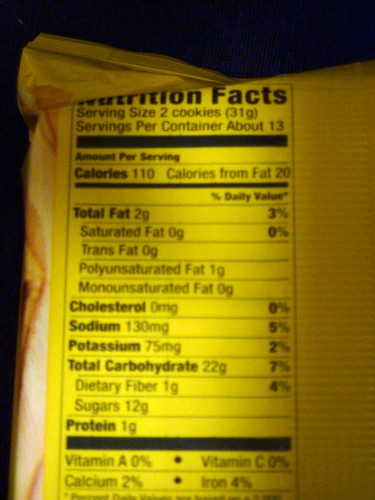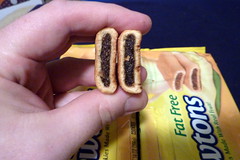Fat Free Fig Newtons sound too good to be true. Are they?
Versus
The answer: Pretty much.
First, lets look at the numbers. The two packages cost the same, but the regular Fig Newtons weigh in at 14 ounces, while that fat free version is just 12 ounces.
It's not that they made the cookies smaller; then didn't. Instead, you get fewer cookies in the Fat Free version. The Regular version has 26 cookies. The Fat Free version has 24.
So there's no cost advantage to the Fat Free. It must be a great alternative for those on a diet right?
The label starts with the absurd notion that a serving is two cookies. Seriously?!?! Who eats just two at a sitting? One of the most misleading things about nutrition information is the absolutely ridiculous servings sizes listed on the label. They are pure fiction for the vast majority of people.
Regardless, a "serving" of regular Fig Newtons is 110 calories with two grams of fat. The Fat Free Fig Newtons are 90 calories per serving with 0 grams of fat. They also have a little less sodium and potassium.
So, a regular Fig Newton is 55 calories with 1 gram of fat and a fat free one is 45 calories.
Is it worth it to switch to fat free to save 10 calories per cookie? That's a little less than a 20% reduction in calories.
Let's looks look at the cookies themselves.
They look similar, but the Fat Free version has more color variation in the breading.
The crust also appears a little thinner on the Fat Free version.
That brings me to taste. It tried them both, knowing which was Fat Free.
The Fat Free version tasted okay (it's not the disaster that the Lean Pockets Cheeseburger was). It did seem a little flat, however. The regular version had a fuller taste. The fruit itself tasted the same; the difference was all in the breading. The traditional Fig Newton crust was more flaky; it crumbled better. The difference was less about flavor, and more about texture.
The GF tried them both in a blind taste test. Historically, she hasn't been a big fan of Fig Newtons,and, with less invested in the process, was in a better position to offer some insight.
She tasted them both and clearly preferred the traditional version over the Fat Free. She described the crust on the fat free version as "more dense," and said the Fat Free version just didn't taste as fresh.
After this limited test, I'd say the traditional Fig Newtons just pop more. The difference between them is all in the crust.
If you plan to sit down and eat all 24-26 Fig Newtons at one, then if might be worthwhile to switch to the Fat Free to save 240 calories. Of course, if you're eating them all at once, you're probably not concerned about the calories.
For a more normal sized snack (5-7), I'd say get the traditional Fig Newtons. The calorie reduction in the Fat Free Fig Newtons just isn't worth the sacrifice in taste and texture.







4 comments:
Worse than this, the individual size packages (with two double-length Fig Newtons) have the exact same calorie count. I went for the original.
For me is was about controlling gallbladder attacks and the less fat I ate in a day the better. Fat-free anything (that tastes good) is a life-saver! Although I also watch sugar because the fat that they can turn into will burden my liver and thusly my gallbladder - and these aren't so good in that regard. On an average sedentary day - a few is fine. But I have to wait until I've done a bike ride to allow more than a couple of portions.
I bought fat free Fig Newtons for the first time by accident I believe. However it happened I'm glad. I've always been a huge fan on Fig Newtons, but I prefer the fat free ones because they are more dense.
I prefer the fat free fig newtons better. The denser breading just tastes better and I don't like the crumbly-ness of the regular ones.
Post a Comment